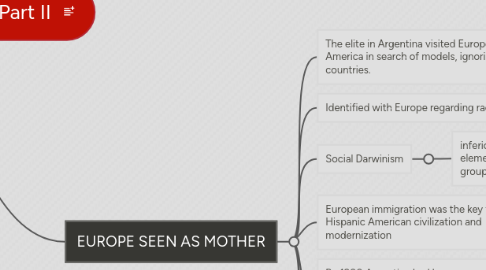
1. THOUGHTS OF EUROPEAN VS BLACK VS INDIAN
1.1. Thought that distant races had developed at different times
1.2. Saw Indians as slowest, stubborn animals
1.3. The Anglo-Saxon whites were seen as the fastest and most civilized race
1.4. Indians seen as living testimony of ancestors but they would not advance. Attacks against them.
1.5. Blacks were childish, illiterate, and alienated from humanity, no moral discernment
1.6. Indians would soon disappear by slow absorption or extermination
1.7. blacks were not able to participate in democracy because they were too inhumane to practice civil rights
2. NATIONALISM
2.1. Spanish language and heritage
2.2. National history taught
2.3. Immigrants integrated in Argentina
2.4. Education
2.5. Catholic Church
2.6. Prostitution, alcoholism, crime was blamed on immigrants
3. CUBA FOLLOWS
3.1. Cuba followed Argentina's way of nation building
3.1.1. The sought European immigration as well instead of unifying the nation
3.2. Did not want to share power with Afro-Cubans
3.3. Civilization was not by Spanish but by British
4. NEW LAWS
4.1. Segregation followed
4.1.1. No blacks allowed in public office
4.1.2. Hard for Afro-Cubans to enter society
4.2. In 1902, prohibition of Chinese into Cuba but encouraged European immigration, wanted to get rid of yellow fever
4.3. No intermarriage in Creole elite families
4.4. No Haitian or Jamaican immigration because it would lead to revolt
4.5. They competed for jobs
5. BRAZIL
5.1. they received more African slaves than any other country
5.2. They had economic space for persons to work
5.3. Slavery wasn't seen as a regional problem
5.4. people didn't believe in theory of biological inferiority
5.5. Brazil was slower than other Latin American countries to follow Europe's ideologies
5.6. Brazilian theologians caught themselves teaching something that contradicted their own Brazilian culture
5.7. This country was frowned upon by Argentines since they reached more success in attracting Europe immigrants
5.8. Their whitening ideology accepted mulattoes but not blacks
5.9. By 1920-30's their whitening problem was being resolved and thought that within a century Brazil would be all white
5.10. Racism seemed to disappear but Hitler brought it back
5.10.1. Small black power movement arose to prevail myth of racial democracy
5.11. There is a multiracial society in Brazil to this day
5.11.1. Older generations still have beliefs of a whiter Brazil
6. MODERNIZATION IN ARGENTINA
6.1. End of 19th century economic growth in Hispanic America
6.1.1. What is to be achieved?
6.2. Limited to minorities, only for elite
6.2.1. How can the achievements of the objectives be measured?
6.3. Little increase in cost of living, loss of land, and exploitation
6.3.1. Are the tasks with which to cope, challenging?
6.4. Caused migration from Europe, China, Japan, Lenanon, and also internal immigration from landless peasants and slaves
6.4.1. Are the goals realistic?
6.5. Argentina was becoming a new variety of the Europe race. Fast process
7. ELITE VS PEASANT
7.1. Elite lived in better conditions
7.2. Poor lived in same conditions they did before independence
7.3. Creole consisted of white Spanish born in Hispanic America.
7.4. Attracting cheap European laborers rather than educated ones in Argentina
8. EUROPE SEEN AS MOTHER
8.1. The elite in Argentina visited Europe and America in search of models, ignoring their own countries.
8.2. Identified with Europe regarding race
8.3. Social Darwinism
8.3.1. inferior races disappear, they are destroyed. Best elements adapt to superior races. Selected groups survive and others vanish
8.4. European immigration was the key for Hispanic American civilization and modernization
8.4.1. whitening process
8.5. By 1900 Argentina had become a nation of predominantly Europeans. It became possible through immigration, and getting rid of the Indians and blacks
8.6. Economy developed through agricultural production and industrialization. Followed Europe's example
8.7. Even Brazil believed that miscegenation would lead to a more civilized population, an uprgade
9. IMPORTANT PEOPLE
9.1. Domingo Faustino Sarmiento
9.1.1. pointed to race as accounting for a multitude of Latin American problems
9.1.1.1. thought of immigration and education as the solution to Argentina's problems
9.1.1.1.1. was confident of black progress more than Indian progress
9.2. Carlos Octavio Bunge
9.2.1. lawyer and educationalist
9.2.1.1. His key problem was that Latin America was their marriages. Bad traits arose from Indians, Arabs, Africans, Jews
9.2.1.1.1. believed in superiority of blacks over Indians. Blacks had stamina for hard work
9.3. Jose Ingenieros
9.3.1. physician and sociologist, known for racial theorizing
9.3.1.1. presented racial reality that transcended European theories
9.3.1.1.1. believed colored races were inferior and not adaptable to white civilization an their fate was to disappear in racial struggle
9.3.1.2. whitening through miscengenation
9.4. Francisco Figueras
9.4.1. Tried to prove Afro-Cuban's racial incapacity to form an independent republic
9.4.1.1. believed natural selection would soon lead to absorption of Blacks
9.5. Fernando Ortiz
9.5.1. Focused on criminology
9.5.1.1. To him, blacks were inferior because of their lack of integral civilization
9.5.1.1.1. believed any race can embrace and copy the European's
9.6. Rafael Serra
9.6.1. promoted creation of separate organizations to defend rights and interests of class of color
9.7. Evaristo Estenoz
9.7.1. created Partido Independiente de Color ans this program integrated class of color
9.7.2. state control of private schools, 8-hour work day, advocated to end racial discrimination, end to ban non-white immigration, black access to higher positions
9.8. Marvin Harris
9.8.1. shortage of whites left no choice but to allow emergence of free class of mixed bloods to serve as artisans and cattle herders
9.9. Nina Rodrigues
9.9.1. studied skulls for African criminology
9.9.1.1. suggested different treatment for colored races who committed crime
